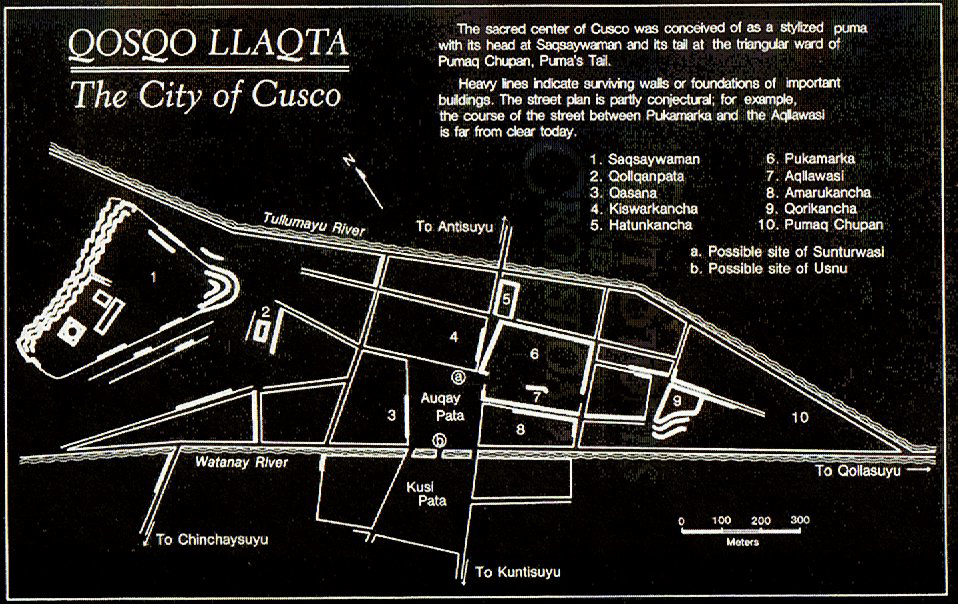It looks like you're using an Ad Blocker.
Please white-list or disable AboveTopSecret.com in your ad-blocking tool.
Thank you.
Some features of ATS will be disabled while you continue to use an ad-blocker.
6
share:
There is found at Qhunqhu Wankani a little known ritual centre of Formative Tiwanaku culture a group of monoliths which i shall attemot to explain are
representing the cult of an also little known Deity of meteoric destruction called Choque chinchay, whose primary symbolism was based upon the Puma,
the locals have given them other names but i wouldn't take that too seriously.
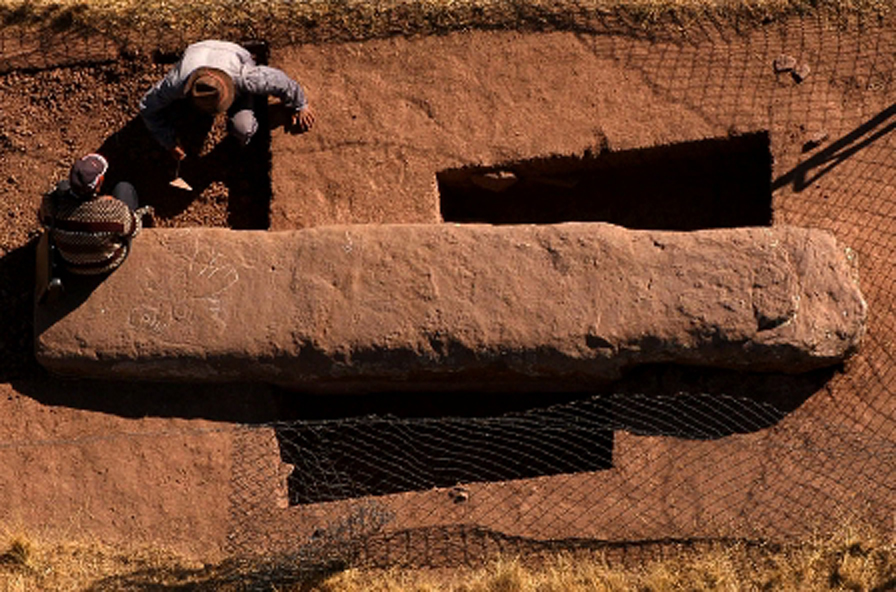
The monoliths are interesting in that they have something of the anthropomorphic about them, elements seen elsewhere such as the hands meeting at the middle, the 'H' symbolism belt and the Divine Twins, but what sets these apart is preponderance of Puma symbolism
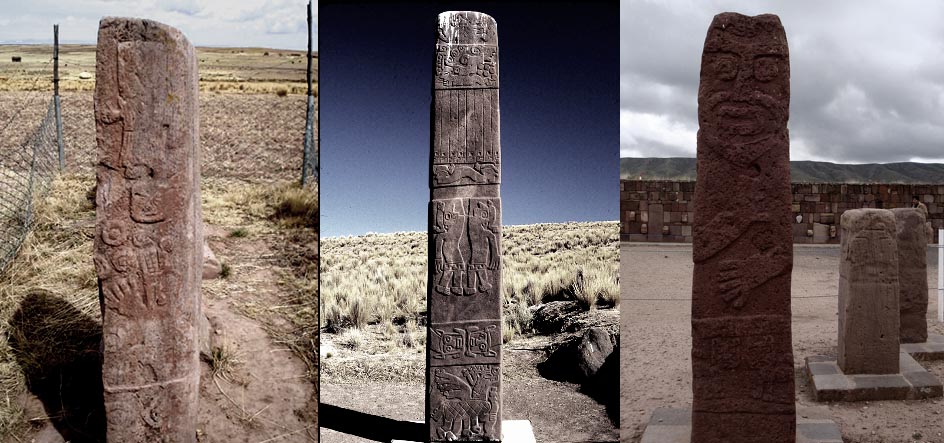
The best site for photographs and drawings of these is here, the hybrid creature i would identify as Choque chinchay is seen well carved on the example below to the left.
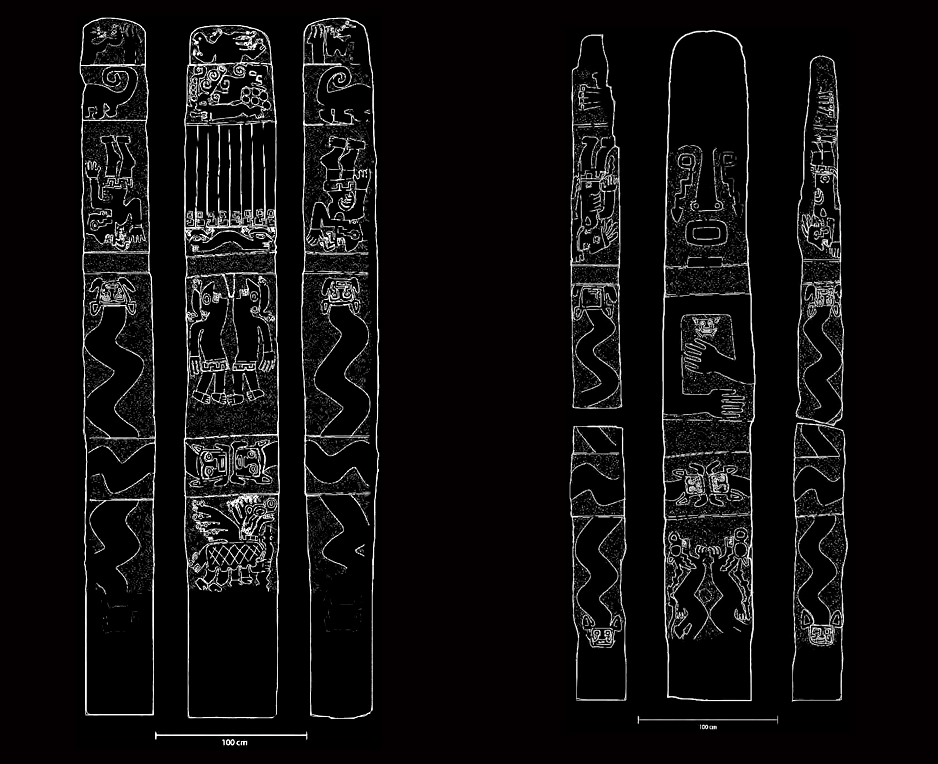
There are other examples of this can be found a common characteristic is that there is also a head at the tail, and while the primary basis is that of the Puma it can take on something of the form of a Dragon.

The serpent like creatures on the Monoliths with the heads of Pumas are interesting, in general Andean symbolism of the Puma the tail can be given to represent rivers, i'm sure that is the general sense there, but of course it is also a question of what type of river or stream is being represented.
In terms of how meteoric impact events were described we have this account;
And here is a vase considered to depict that very beast, which has correlations to Choque chinchay;
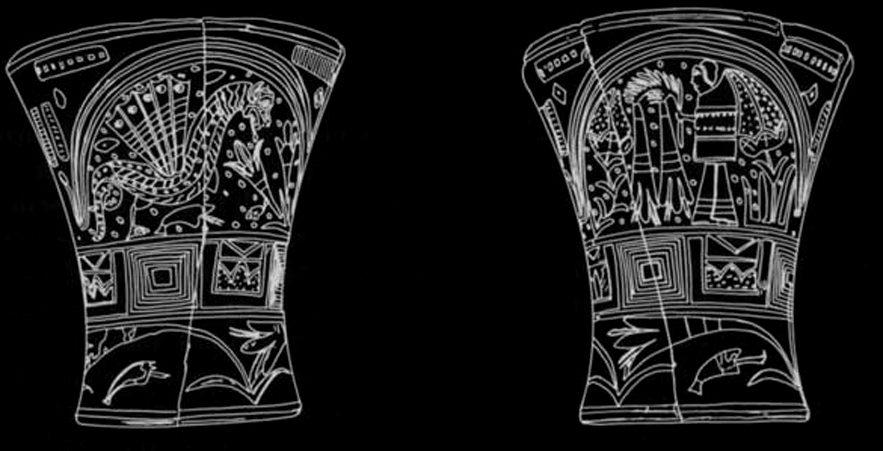
An Altar dedicated to Choque chinchay simply resembles the surface of the Moon.
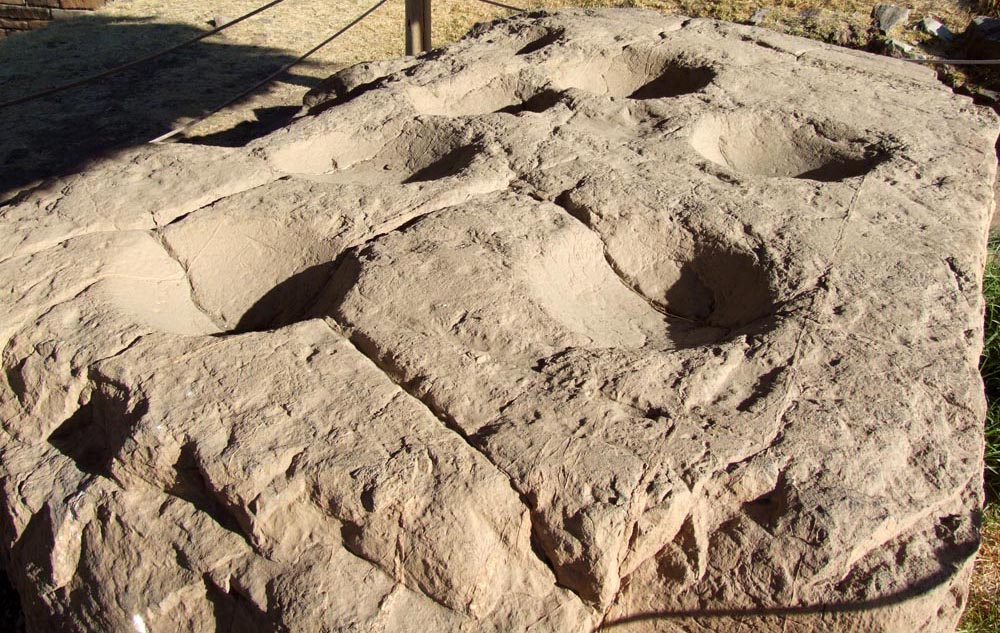
There is sound consideration here in Animal Myths and Metaphors of the overall symbolism of the Puma to Andean people, were Cities such as Cuzco were understood to represent the Puma, with the people being the basis for the body and the Government the head of such, and the author also makes some important general considerations of what the Puma represented compared to the Jaguar;

He also notes that the Inca were familiar with the notion of meteorites as a useful weapon of war;

Were the meteorite strike would be an attribute of the storm God, later referred to as 'lightning Felino' or Choque chinchay
There has been some attempt to identify an associated constellation based upon a weird colonial period schematic of sorts, from here;

I think more likely an associated narrative extending from Perseus through the Pleiades toward Orion, as would be the case in the Near East for lightning Felino, but current understanding of Andean constellations is simply a mess.
The translation of choque, gold, + chinchay, jaguar, literally, golden jaguar, that which makes gold stand forth, it was understood as the organizing principle of the kaypacha, maintenance of fertility and diversity, also related to the notion of a Third Gender in terms of fusion, similar considerations relating to Inanna and the Pleiades in Mesopotamia.
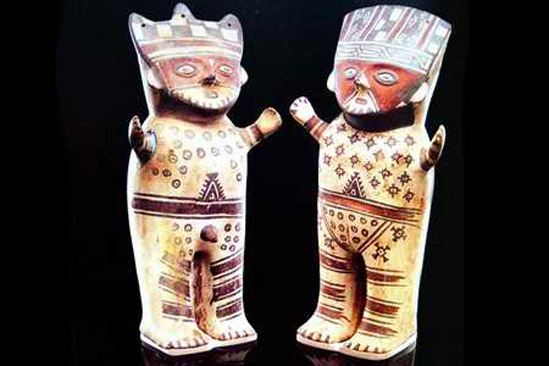
Brien Foerster visited the site of the Monoliths, he does look for interesting obscure sites i'll give him that...

Tata Kala (stone father) Jinchun Kala (stone with ears) and Wila Kala (red stone). According to the iconography of these lithic steles, because tugal Qhunqhu Wankani data concludes that most likely from a "primitive" time pre Tiwanaku
Contextualizing the site Qhunqhu Wankani
The monoliths are interesting in that they have something of the anthropomorphic about them, elements seen elsewhere such as the hands meeting at the middle, the 'H' symbolism belt and the Divine Twins, but what sets these apart is preponderance of Puma symbolism

The best site for photographs and drawings of these is here, the hybrid creature i would identify as Choque chinchay is seen well carved on the example below to the left.

There are other examples of this can be found a common characteristic is that there is also a head at the tail, and while the primary basis is that of the Puma it can take on something of the form of a Dragon.

The serpent like creatures on the Monoliths with the heads of Pumas are interesting, in general Andean symbolism of the Puma the tail can be given to represent rivers, i'm sure that is the general sense there, but of course it is also a question of what type of river or stream is being represented.
In terms of how meteoric impact events were described we have this account;
The Indian chronicler Joan de Santa Cruz Pachacuti had during the birth of Amaro Topa Inka, while east of Cusco had released an amaro of
"... Serro of Pachatusan very fierce beast, half a league long and Gruesso two fathoms and a half wide, and ears and tusks (and beard)
The animal walked through Yuncay Pampa and Sinca, then entered the lagoon Quibipay. Meanwhile, the Ausangate (southeast of Cusco), came two comets of fire toward the volcano Putina (Arequipa); while another comet fire was heading north toward Guamanga, in whose path there were three or four peaks, including Salcantay and Urubamba.
"... Animals with wings and ears and tails and four feet and shoulders above many thorns and fish, and from afar they say that fire seemed to them all. "
And here is a vase considered to depict that very beast, which has correlations to Choque chinchay;

The drawings of this vessel were recorded and then painted with a dominant red, yellow and green, and are divided into three horizontal and parallel strips. The top covers from the mouth to the middle of the vessel; a woman with a branch of cantutas who makes a gesture of offering flowers to a ferocious animal, hybrid snake, bird and feline, which goes to her trampling flowers
Both are surrounded by clear spots and, in turn, each character is under an arc whose ends converge in respective heads of pumas
Incan graphic metaphor
An Altar dedicated to Choque chinchay simply resembles the surface of the Moon.

There is sound consideration here in Animal Myths and Metaphors of the overall symbolism of the Puma to Andean people, were Cities such as Cuzco were understood to represent the Puma, with the people being the basis for the body and the Government the head of such, and the author also makes some important general considerations of what the Puma represented compared to the Jaguar;

He also notes that the Inca were familiar with the notion of meteorites as a useful weapon of war;

Were the meteorite strike would be an attribute of the storm God, later referred to as 'lightning Felino' or Choque chinchay
There has been some attempt to identify an associated constellation based upon a weird colonial period schematic of sorts, from here;

Lozano states that the original settlement was shaped like a jaguar or puma, animal sacred to Andean peoples: "The first plot was linked to the constellation of the Southern Cross, which serves to indicate the construction of the Temples temples or shrines.
The second path is associated with the constellation Choquechinchay or 'lightning Felino', whose figure delimits the sacred place where the major temples were located. The latter coincides with the constellation we know as Orion, which makes up the cat's head, the tail being the Pleiades or ".
Lozano states that "... the Choque chinchay constellation displayed in a mysterious cosmographic map of the seventeenth century by the Indian Juan Santacruz Pachacuti Yamqui Sallkamayawa, which is a copy of a figure that was recorded on the altar of the Temple of Coricancha in Cuzco
Returning to the structure of the city based on the constellation of jaguar, Lozano says, "the figure of the cat runs from northeast to south , in an attitude of wait, crouching on natural terrain slopes as if resting their feet over the river and look to the southwest "... and then reiterates: " ... this position is the projection on the ground constellation lightning Felino "
I think more likely an associated narrative extending from Perseus through the Pleiades toward Orion, as would be the case in the Near East for lightning Felino, but current understanding of Andean constellations is simply a mess.
The translation of choque, gold, + chinchay, jaguar, literally, golden jaguar, that which makes gold stand forth, it was understood as the organizing principle of the kaypacha, maintenance of fertility and diversity, also related to the notion of a Third Gender in terms of fusion, similar considerations relating to Inanna and the Pleiades in Mesopotamia.

kaypacha-The multiple levels and visionary experiences of this highly animated cosmos seem to have been created in order to initiate individuals into a reality that mirrors their own divinity, also referred to as the realm of humanity's hypnotic slumber and the domain of the otorongo achachi, or grandfather jaguar, and choque chinchay, or puma.
Brien Foerster visited the site of the Monoliths, he does look for interesting obscure sites i'll give him that...
edit on Kam22938vAmerica/ChicagoMonday0829 by Kantzveldt because: (no reason given)
edit on
Kam22938vAmerica/ChicagoMonday0829 by Kantzveldt because: (no reason given)
Here's another interesting fact about the Wnakani site, they had a processing room to cover the remains of people in a plaster substance, for reasons
best known to themselves...
Wankane Ritual
At an ancient ritual complex in Bolivia, archaeologists discovered the ruins of a room where dead bodies were dissolved down to their bones in sizzling pots of caustic chemicals.
People traveling in llama caravans may have brought their deceased relatives to be "defleshed" in this way at the complex (on purpose) so they could leave with the plaster-coated bones as relics, according to a new study.
Founded during the late first century A.D., the site known as Khonkho Wankane was one of the smaller ceremonial centers to pop up in the Andes Mountains around Lake Titicaca before the rise of the more famous nearby ancient city of Tiwanaku
At its height, Khonkho Wankane (sometimes spelled Qhunqhu Wankani) covered about 17 acres (7 hectares) with at least three sunken temples, several large platforms, a big central plaza and quite a few circular houses.
Wankane Ritual
new topics
-
Has Tesla manipulated data logs to cover up auto pilot crash?
Automotive Discussion: 1 hours ago -
whistleblower Captain Bill Uhouse on the Kingman UFO recovery
Aliens and UFOs: 6 hours ago -
1980s Arcade
General Chit Chat: 8 hours ago -
Deadpool and Wolverine
Movies: 9 hours ago -
Teenager makes chess history becoming the youngest challenger for the world championship crown
Other Current Events: 10 hours ago -
CIA botched its handling of sexual assault allegations, House intel report says
Breaking Alternative News: 11 hours ago
6

